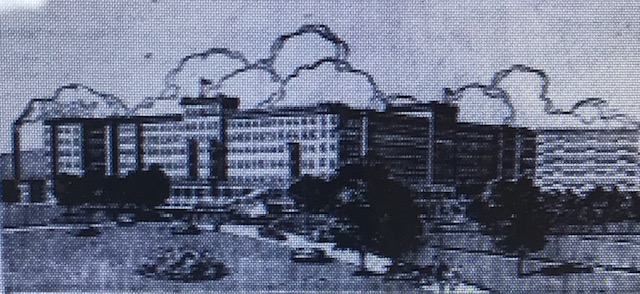
Blurred, mixed, and ragged. Most of the time you’re dealing with lesser evils and shifting boundaries.
Sound familiar? Then you’re right at home with influenza on Day 53, October 30, 1918.
There are places where things are getting worse. The leading newspaper in Idaho informs readers that “stricter rules may be needed to curb influenza.” Nearby, the health officials of Washington state decide to up the ante, as it were, with face masks. The order is to now wear face masks of six-ply thickness. Southwestern Virginia has become the hardest-hit part of the state, just one week after a local Red Cross director had congratulated the population for doing a great job of reducing the outbreak of influenza.
The entire family of 19-year old Florence Phye—all eight of them—continues to suffer in the Elks lodge dining hall-made-into-a-hospital-ward in Loveland, Colorado. The smell of disinfectant cleaning fluid is now the only detectable aroma. Sizzling steaks are a thing of the past, at least temporarily.
But you can feel something changing. You can’t call it a corner because that’s too definite. No right angles. Softer and rounded yet somehow you get the sense you’re entering a different space.
Can things be turning toward the better?
Public meetings of all types are now allowed in Philadelphia and Washington DC. At the University of Minnesota in Minneapolis the arguments are now over how soon the students should be allowed back on campus, perhaps in the next day or so. By the dozens, small towns and large cities are bickering about what to do about tomorrow—should children be allowed to enjoy Halloween outside of their homes? The vehemence of the Halloween debates are made more intense because, in fact, there seems to be a noticeable weakening of influenza’s chokehold on numerous communities.
In Chicago, thousands of people, with large numbers of African-American participants, showed up for yesterday’s rescheduled film-making in Grant Park. They celebrated the war effort and the role of African-American soldiers in that effort. And again, mysteriously, a different atmosphere marked the moment—not really like the earlier Liberty Loan events but rather more of a public reminding itself of a normal life. Also in Chicago, health director John Dill Robertson—the Dill Pickle—announces that theaters on the northside of the city can reopen. Theater owners agree that all performances will include a 2-minute “health talk” to ensure that audience members know how to stay influenza-free in the days ahead. Philadelphia’s health department now publishes actual day-to-day data—cases and fatalities—from the month of October. The willingness to share information hints at a recovery of confidence among local decision-makers in having some control over the situation. African-American Dr. John P. Turner echoes this confidence in hoping that a rising public mood in the city will produce a “democraticization” of medicine with broader acceptance and support for minority doctors.
A leisure company, the French Lick Springs Hotel in southern Indiana, dips a toe in normal water. Its owners judge the time is right to advertise in Chicago newspapers. They design an ad aimed at a specific Chicago audience: those with disposable cash, either never having influenza or nearly recovered, and are eager to get out of the city on a short holiday. Good food, good drink, good gambling, good golf, and good shopping awaits them. Just a few-hour ride on the Monon Line and you’ll get the good stuff denied these past few weeks.
Positive signs, to be sure, yet even here the negative persists. The Halloween debates are, after all, arguments between one side as equally committed to remaining in lockdown as another side is to removing it. The Philadelphia decision to open up gatherings is far from unanimous—Catholic nuns succeed in keeping private schools closed. Janitors will still be roaming the halls of public schools to clean and disinfect. Teachers will remain home if they are sick or caring for sick children. Sick children will continue to recover away from school. And then there are the widespread reports of influenza either worsening or not letting up.
It’s not exactly groping in the dark, where answers are as absent as the light. It’s more about fog and forms in the gray. Something is out there. It’s just hard to see all the details.
A thought for you on Day 53, May 4, 2020, fifty-three days after President Trump declares Covid-19 a national emergency—the number of days. Let’s take a moment and marvel at the dates of 1918 and 2020. By my count, since the national declaration of emergency, we’re at 53 days. In 1918, going from the Fort Devens, Massachusetts which tends to mark the second-wave outbreak of influenza, they’re at 53 days. Amazingly, in both times, you can sense a desire and see a decision in several American communities: they are restoring normal life. Also, the quest to return includes fractions, pieces, parts, and phases. Chicago and Philadelphia are powerful examples of opening a little here and there. We can argue and debate the merits of opening as a general point and the execution of opening in specifics. What’s inarguable is that the trend and time span track so closely in the two eras. Two things true then will be true again—first, to begin normalization requires pushing through a field of gray and, second, a degree of raggedness, jaggedness, and unevenness follows the push. As a leader, you will be tested in both instances. Gray fields and rough edges, they will be your next testing grounds. These are uncomfortable spaces in standard moments. They are downright prickly in moments like ours.

(note to reader—I invite you to subscribe to this series/blog. The purpose of my posting in this series is the purpose of my enterprise at Historical Solutions—to explore the past in a new way that brings new and different value to you, both in the present (this minute) and on the edge of the future (what’s ahead or forward of this minute). The past is everything before now, the totality of all time before the present; history is a set of very small slices of the past that, for a particular reason, have been remembered. If you wish to contact me privately, please do not hesitate to text or call 317-407-3687)







